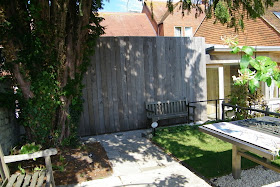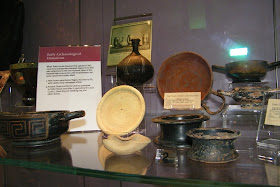Caterina Sforza by Lorenzo Di Credi
Ever since I have started reading about Renaissance Italy, there is one woman who has cropped up again and again. A woman who went against pretty much everything that was expected from a woman in Renaissance Italy. Her name was Caterina Riario Sforza De Medici, but more commonly known as Caterina Sforza. She has come down to us through history as the She-Wolf of Forli, a woman who held out against the Borgia Pope, a woman who apparently stood on the ramparts of her city during the siege of Forli and lifted her skirts crying that her enemies could kill her children as she had the means to make plenty more. But was she really the tyrannical leader that Machiavelli makes out in "The Prince" (he really went off her after an incident when he was sent to her court as an ambassador)? Or was she just a woman trying to find her place in a world that was controlled by men? Whatever the case, she certainly made her mark as a woman who stood her ground against everything that life threw at her. She suffered huge loss throughout her life yet always remained strong. They called her a tyrannical she-wolf. But was she really? Over the next few posts I will be concentrating on the life of this remarkable woman, starting as always with her birth and early life.
Caterina Sforza was born in Milan in 1463, the illegitimate daughter of Galeazzo Maria Sforza and Lucrezia Landriani. As a bastard, had she been born anywhere else other than Italy, she would have faced a life of stigma and been unable to form a respectable standing in society. But as we have seen in the life of Rodrigo Borgia, bastard children were the norm in Renaissance Italy and Caterina was raised in her fathers house alongside his legitimate children. And as many other bastard children did in Renaissance Italy, she carried her surname with pride. The Sforza family rose to be the ruling family of Milian, despite the fact that they started out as a peasant family. In 1390, Caterina's great great grandfather had become a condottiere, or mercenary, and fought in various wars and skirmishes that were commonplace in the Italian principalities.
Map of Italy showing the Italian Principalities as they would have been
Italy during the fourteenth century, and indeed beyond, was split up into different republics or principalities. And each state had it's own ruler. Machiavelli describes this in his work "The Prince":
"Principalities are hereditary, with their prince's family long established as rulers, or they are new. The new are completely new, as was Milan to Francesco Sforza, or they are like limbs joined to the hereditary state of the prince who acquires them, as is the kingdom of Naples in relation to the king of Spain. Dominions so acquired are accustomed to be under a prince, or used to freedom, a prince wins them either with the arms of others or with his own, either by fortune or by prowess".
Due to his prowess on the battlefield in the 1390's, as these principalities fought amongst themselves for alliances or border disputes, Caterina's great great grandfather was given the nickname of Sforza, which meant Strength. After moving between states and fighting for different states at different times, he settled and took service in Milan. His new lord was Fillipo Maria Visconti. Whilst he lived in Milan, he had an illegitimate son named Francesco who proudly took on the Sforza name. Francesco married the illegitimate daughter of Fillipo, Bianca Maria, and when Fillipo died without a single heir in 1447 it meant that Francesco Sforza was close to claiming the duchy of Milian. But, alas, on the day of Fillipo's death the Milanese declared the city a republic and destroyed the Visconti castle. Many of the Italian states didn't like this idea and Milan soon found itself facing some strong enemies. Venice ended up plucking away at the borders of Milan in retaliation and the republic had no choice but to hire the Sforza army of condottiere. Francesco quickly retook the captured towns and in 1448 signed a peace treaty with Venice. He then returned to the city of Milan and began a siege of the city that lasted for months. As the food began to run out, Milan opened its gates to Francesco and he was made ruler of the city.
Francesco Sforza, unknown artist
Francesco's son was Galeazzo Maria who continued the tradition of using the Sforza name as well as developing Milan as his father had done before him both with technical developments and military developments. He was also an incredibly lavish man. Upon the death of his father in 1466, the new ruler of Milan put on incredibly lavish displays. Yet he was an incredibly self indulgent man and managed to earn himself a lot of enemies during his reign.
Galeazzo Maria Sforza by Piero Pollaiuolo
Galeazzo's daughter, Caterina, was just three years old when her father became Duke of Milan. And along with the court, she took up residence in the newly renovated castle of Porta Giovia. Her childhood was surrounded by incredible opulence and would have wanted for nothing. Her education was the best that money could buy, and she took her lessons alongside her half brothers and sisters; the legitimate heirs of Galeazzo. Her tutor was a man by the name of Francesco Filefo and under his tuition she learnt Latin and read the works of Cicero and Virgil - it helped that the castle held a huge library full of classic works. The young Caterina also read the stories of the saints as well as devouring French romance books. She also spent long hours learning to bear arms which was a tradition in a family that had started out from a condottiere. She not only would have learnt how to use weapons but also how to ride and hunt. It was not normal at this time that women would have learnt such things. This education gave her an advantage that would become more and more obvious as she grew up. Very few women at this time learnt how to bear arms - Isabella of Castille (the mother of Katherine of Aragon) learnt to hunt and ride but spent more of her time praying than learning the arts. Isabella D'Este was incredibly literate and loved art but unlike Caterina was not given instruction in how to ride and hunt. Thus Caterina had the advantage over her peers. And this would become more and more obvious as the years went on.
What else helped shaped the She Wolf to be? During her childhood she was certainly surrounded by incredibly strong willed women including her grandmother, Bianca Maria Visconti, who raised her in her earliest years. Bianca co-ruled the City of Milan with her son Galeazzo during the first years of his reign until he decided it was time to rule on his own. He believed that she was treating him like a child. Caterina also had a close relationship with her stepmother Bona who was an incredibly beautiful woman. She was a fantastic horsewoman and always went with Galeazzo on the hunt.
In 1473, at the age of 10, Caterina was thrown into the marriage market. In the October, following a long trip away from his court, Galeazzo became exceptionally ill He had smallpox and believed, with a finality that shocked his family, that he was going to die. However Galeazzo recovered, much to everyones surprise, and set about transforming Milan so it would compete with the great courts of Italy. He transformed the city into a hive of art, architecture and music and of course, Caterina herself benefitted from this. Yet during the Christmas of 1472, Caterina's father and Giralomo Riaro were discussing marriage. And he was also the nephew of the Pope. His contemporaries described him as fat, with pale skin and with a sickly disposition, he was not well read nor the brightest tool in the box. And he owed everything to his position as the Pope's nephew. Giralomo's original bride however was not Caterina, it was Constanza Fogliano. However her mother refused to allow her daughter to have her daughter taken by a man of inferior rank and preferred to wait until she reached the age of 14, the legal age of consummation. On 6th January 1473 the Marquis of Mantua wrote to Galeazzo offering a compromise - Constanza's mother should allow her daughter to be "put to bed" with Riaro, and with other women present. It would then be considered as a form of consummation although no sexual intercourse would take place. Giralomo refused and threatened to leave, and so Caterina's father needed to keep the man happy. He offered to substitute Caterina as his bride instead of Constanza. Riaro agreed and on January 17 1473, the marriage contract was agreed. Giralomo Riaro was then thirty three years of age, his bride to be was just 10; this was the norm in Renaissance Italy and the marriage agreement certainly was not full of romance like we see today. The two would have taken part in a betrothal ceremony, where a notary asked them if they wished to be married. The couple would then respond with "I do" (or rather volo in Italian). The certificicate would then be signed and the agreement finalised with a ring and a kiss. If the couple were over the age of 14, the marriage could then be consummated although this did not usually happen until the bride moved into her husbands house. And once the marriage was consummated, there was no going back. The bride had officially been possessed by her new husband, and if she left her husband then it would spark great scandal.
Giralomo Riaro, in a fresco by Melozzo of Forli
The couple consummated their marriage, despite the fact that Caterina was below the legal age, and Riario's uncle the Pope was not pleased with this. He was forced to issue a papal bull to absolve all parties in the illegal sexual act.
Just one week after the marriage was completed, Giralomo Riaro left Milan and travelled back to Rome. She then remained in her father's care and did not see her husband for the next three years. In her father's house, despite now being a married woman and Countess, she continued her studies and waited until she could join her husband as she turned fourteen. Riaro however spent the next three years with various mistresses, and did not write to his new wife at all. She stayed in her fathers house, and watched as her father passed away and her stepmother Bona became regent for the new Duke, until 1476. Then, as she turned 13, Bona wrote to Giralomo confirming the marriage agreement and stating that at the age of 13, Caterina was old enough to join her husband in Rome. The official wedding was then organised, although Giralomo claimed that he could not attend his own wedding due to biusness reasons. Instead, she was married by Proxy in an unremarkable ceremony (due to the fact that her father had recently been murdered) and just a few days later she said goodbye to her childhood home forever.
Further Reading
Elizabeth Lev, The Tigress of Forli,
Niccolo Machiavelli, The Prince
Paul Strathern, The Artist, The Philosopher and the Warrior
Ernst Breisach, Caterina Sforza: A Renaissance Virago
Christopher Hibbert, The Borgias and Their Enemies
Jacob Burckhardt, The Civilisation of the Renaissance In Italy
Christopher Hare, The Most Illustrious Ladies of the Italian Renaissance









































